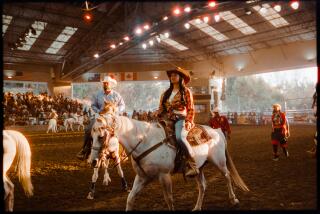Waltzing a Half-Ton Bull Around Is His Idea of Fun
- Share via
Lyn Sherwood’s idea of a good time is to plunk down nearly $1,000 and buy a 500-pound deadly animal that will, for about 20 minutes, try its best to kill him.
As part of this fun, Sherwood has had a handful of teeth knocked out, torn the ligaments in one knee, been variously battered and bruised and has suffered a large puncture wound in his groin.
He’s been doing it for almost 30 years. But, he says, in October he will enter the ring and kill an animal for the last time as an aficionado practico --an amateur bullfighter.
Sherwood, 48, who operates a one-man advertising and public relations agency out of his home in San Juan Capistrano, has been fighting bulls since he first stepped into a ring in Spain in 1956. Since then, he says, he has killed nearly 40 bulls in Spain and Mexico and become thoroughly absorbed in the life of the bullfighter as the editor and publisher of Clarin (Spanish for “clarion” or “trumpeter”), a magazine that he claims is the only one in the world devoted to the art of the matador. Other bullfighting publications throughout the world, he said, are published in newspaper format.
By his own reckoning, when he retires from the ring next month, Sherwood will reduce the amateur bullfighter population of the United States by slightly less than 9%. There are, he says, perhaps a dozen men in the country who currently are willing to--and regularly do--go sword-to-horn with a quarter-ton fighting bull for no pay whatever.
(There are, Sherwood said, three active professional American matadors: David Renk of Houston, Diego O’Bolger of Tuscon and Raquel Martinez of San Diego.)
But, Sherwood said, age and, to some extent, economics have caught up with him. With advancing years, he said, comes a lessened sense of timing, technique and grace, which in the bullring can be fatal. And, he added, amateurs are obliged to pay for the bull they fight and kill. The cost, he said, is nearly $1,000, which entitles the bullfighter to only fight the bull, not take home the meat after the animal is butchered.
Illegal in U.S.
Also, bullfighting to the death, in which the bull’s horns are not blunted and the animal is killed, is illegal in the United States. Both amateur and professional bullfighters must fight in Mexico.
Sherwood does not fit the classic image of a matador--lean and muscled.
Bearded and balding, with short limbs and a round face, Sherwood stands 5 feet, 8 inches tall and admits to being 20 pounds overweight.
Nonetheless, he said, he learned quickly how to face down and kill an angry fighting bull soon after he became fascinated by the matadors of Spain.
In 1956 Sherwood was attending Long Beach City College on a business scholarship and was “bored out of my mind,” he said. His father, an engineer, had just taken a job working on a project in Spain, and Sherwood decided to follow him and take a job there as a warehouseman.
Watching the Spanish matadors, Sherwood said he became more and more enthusiastic and eventually joined the ranks of the aficionados--true devotees of bullfighting.
Finally, he said, he decided to learn the torero’s--the bullfighter’s--trade himself.
“You go out to the ranches where they breed the bulls and you learn there,” he said. “You watch and you try to mimic what the others are doing,” Sherwood said. “After a while, if you’re lucky someone who really knows what he’s doing will teach you. But you get your head kicked in while you’re learning. While I was there, I learned a lot partly because I was a novelty. I was a Yankee.”
Killed His First Bull
On Easter Sunday, 1956, Sherwood killed his first bull in the ring in Spain. Six months later, in another performance, he was awarded an ear, a token given to a bullfighter who has shown particular skill against a bull.
“I was 18 then, and I thought I was immortal,” Sherwood said. “And the bulls--they were merely animals. I was enjoying the glory of it.”
During the next year in Spain, however, reality struck hard. Sherwood was gored in the groin and the wound, he said, became badly infected.
“I gave away my suit of lights and went right back to college in Long Beach,” he said.
After studying journalism and broadcasting, Sherwood held various jobs at Southern California radio and television stations during the 1960s and continued to attend bullfights and associate himself closely with the matador’s life. But he did not enter the ring again until 1969, when he “fought a yearling cow at Tecate and it chased me all around the ring. I was terrified.”
The courage to fight returned gradually, he said.
“I continued to fight when I could--although terrified--and then I started listening to a self-hypnosis tape about an hour before I’d go into the ring,” he said. “It didn’t really take away the fear, but it helped my concentration.”
As an amateur, Sherwood said he uses all the tools--capes, banderillas , killing swords--that a professional matador would bring into the ring with him. And, he added, he takes many of the same risks, although the younger 2- and 3-year-old bulls that amateurs fight are less dangerous than the full-grown 5-year-old bulls--which can weigh more than 1,000 pounds--that are seen in the professional ring.
‘Only Natural Born Killer’
“The younger bulls ar naive,” Sherwood said. “They’re dangerous, but they don’t know where their horns are yet. But the older bulls, they know. They’ll attack absolutely without provocation. They want to kill you. The fighting bull is the world’s only natural born killer. That’s the only reason they’re bred.
“But to be able to take all the brute force of that animal, who’s trying his damndest to kill you, and make it into something graceful, something beautiful, like ballet. . . , it’s extraordinary.”
Sherwood said he once viewed his participation in the ring as a kind of sport. His growth temporarily stunted in late childhood as a result of an injury to the pituitary gland in a car wreck, Sherwood said he “couldn’t really participate in many sports. I tried out for baseball and football, but I was always the runt, the last one chosen. I had a terrible inferiority complex, and I saw bullfighting as a way to participate in something that didn’t require great size. I found out that it was really an art.”
The idea, Sherwood said, is not merely to avoid the bull’s charges. The torero’s posture, the position of his hands, legs and arms, his willingness to stand still while leading the bull around his body, the seeming effortlessness in keeping the cape short inches away from the bull’s face throughout an intricate pass--these and other tiny details not usually seen by the casual fan are what distinguish bullfighting as an art form, he said.
“The death rate among bullfighters today is low because of penicillin and good medical care,” Sherwood said. “But the average number of grave gorings a matador will receive during his career--gorings where he’s in danger of death and given the last rites of his church--is around six. It’s inevitable. This is a very serious business.”
A matador is considered to have reached retirement age when he is about 35, Sherwood said.
In bullfighting circles, Sherwood probably is better known as editor and publisher of Clarin than as aan aficionado practico . More than half the magazine’s 10,000 circulation is in Southern California, he said, although there are subscribers from as far away as the Philippines and the Soviet Union. It is published irregularly, six to eight times a year, Sherwood said.
Clarin, which is produced out of Sherwood’s home and printed in Mexico, is filled with photos of matadors in action (most of them taken by Sherwood) as well as descriptions of matadors’ performances, descriptions that often offer more than passing critical comment.
For example: A cutline below a picture in the magazine describes matador Antonio Lomelin as “deeply talented, handsome and extremely popular. . . . But his inconsistency and tendency towards narcissism detract from his greatness.”
Chased by a Matador
Sherwood claimed that his outspokenness on two occasions prompted one bullfight promoter to threaten him with a gun and a matador, stung by criticism, to chase him around the pool at Tijuana’s La Sierra motel with his four-foot killing sword.
He also becomes astringent when speaking of the typical bullfight crowd and of those who condemn bullfighting as cruel.
“I don’t have any respect for bullfight crowds,” he said. “Most of them don’t know anything. And usually the Americans are even more knowledgeable than the Mexicans. The Americans are like converts, so they tend to study bullfighting. The Mexicans don’t.
“Is bullfighting cruel? Sure it’s cruel. On moral grounds you can’t justify it. But if people don’t like it, they don’t have to go to see it. The people who try to prevent me from enjoying my vice are just hypocrites.
“In Mexico and in Spain, bullfighting’s part of their culture. We Anglos have a hang-up when it comes to death. We fear it and hold it in awe. But the Latins revere it. To die in honor, that’s the thing. To them, the bull is dying with honor.
“They consider it an art, and so do I. It’s about the second greatest feeling in the world when it’s done right. I’ve found great joy in it.”
More to Read
Go beyond the scoreboard
Get the latest on L.A.'s teams in the daily Sports Report newsletter.
You may occasionally receive promotional content from the Los Angeles Times.










